KIA Amanti 2008 1.G Manual PDF
Manufacturer: KIA, Model Year: 2008, Model line: Amanti, Model: KIA Amanti 2008 1.GPages: 283, PDF Size: 20.47 MB
Page 71 of 283
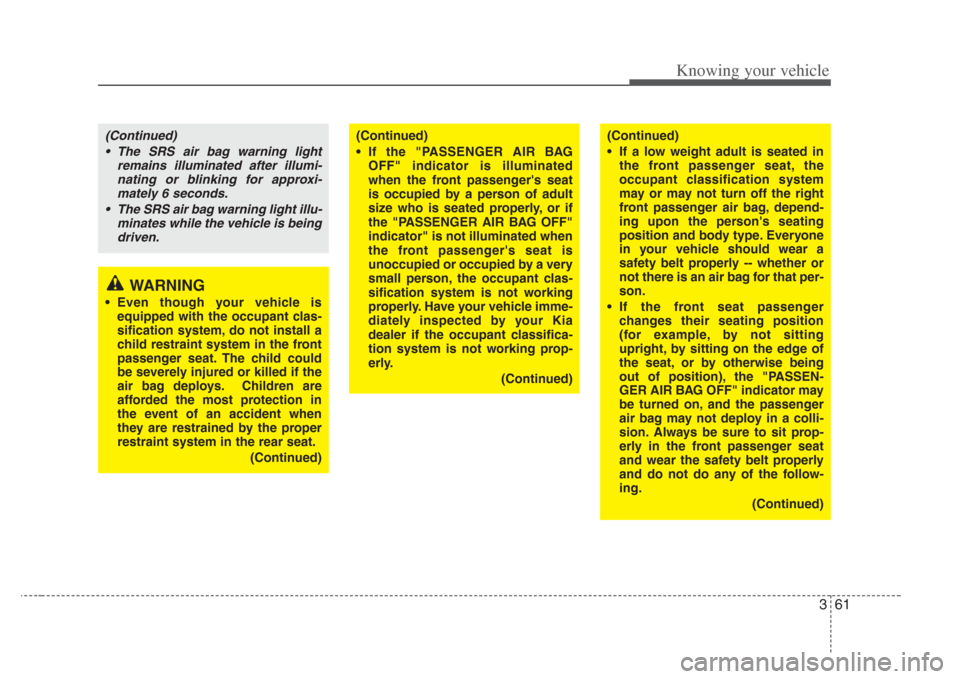
361
Knowing your vehicle
WARNING
• Even though your vehicle isequipped with the occupant cla s-
sification system, do not install a
child restraint system in the front
passenger seat. The child could
be severely injured or killed if the
air bag deploys. Children are
afforded the mo st protection in
the event of an accident when
they are restrained by the proper
restraint system in the rear seat.
(Continued)
(Continued)
• If the "PASSENGER AIR BAGOFF" indicator is illuminated
when the front pa ssenger's seat
is occupied by a per son of adult
size who is seated properly, or if
the "PASSENGER AIR BAG OFF"
indicator" is not illuminated when
the front passenger's seat is
unoccupied or occupied by a very
small per son, the occupant cla s-
sification system is not working
properly. Have your vehicle imme-
diately ins pected by your Kia
dealer if the occupant cla ssifica-
tion system is not working prop-
erly.
(Continued)(Continued)
• If a low weight adult is seated in
the front passenger seat, the
occupant classification system
may or may not turn off the right
front passenger air bag, depend-
ing upon the per son's seating
position and body type. Everyone
in your vehicle should wear a
safety belt properly -- whether or
not there i s an air bag for that per-
son.
• If the front s eat passenger
changes their s eating pos ition
(for example, by not s itting
upright, by sitting on the edge of
the seat, or by otherwi se being
out of position), the "PASSEN-
GER AIR BAG OFF" indicator may
be turned on, and the pa ssenger
air bag may not deploy in a colli-
sion. Always be sure to sit prop-
erly in the front pa ssenger seat
and wear the safety belt properly
and do not do any of the follow-
ing.
(Continued)(Continued)• The SRS air bag warning light remains illuminated after illumi-nating or blinking for approxi-mately 6 seconds.
• The SRS air bag warning light illu- minates while the vehicle is beingdriven.
Page 72 of 283
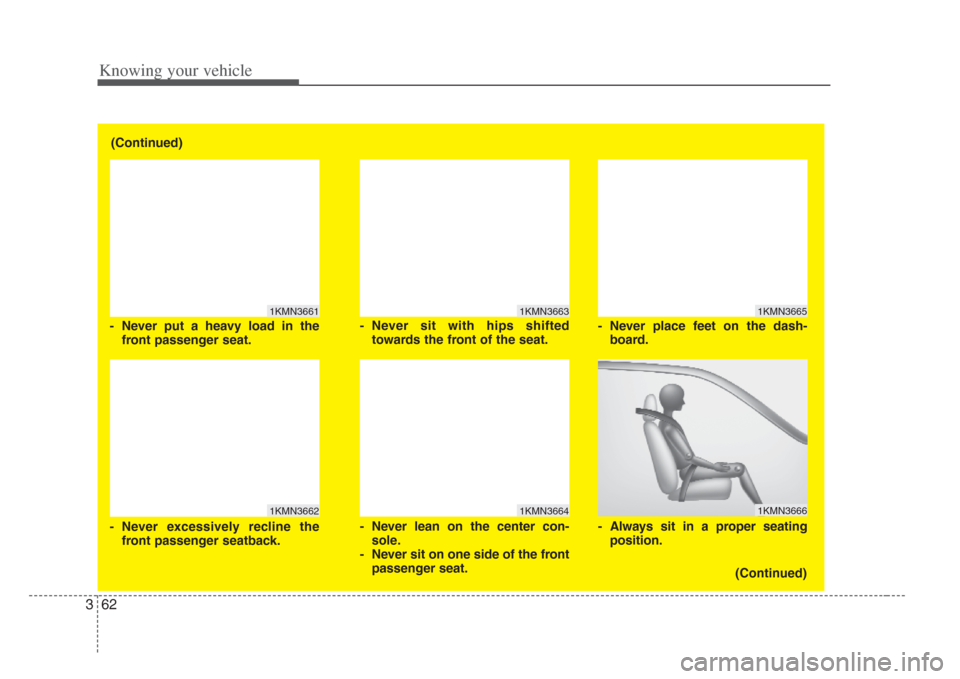
Knowing your vehicle
623
1KMN3663
1KMN3664
1KMN3665
1KMN3666
- Never sit with hips shifted
towards the front of the seat.
- Never lean on the center con- sole.
- Never sit on one s ide of the front
passenger seat. -Alway
s sit in a proper s eating
pos ition.
- Never place feet on the da
sh-
board.
(Continued)
1KMN3661
1KMN3662
- Never put a heavy load in thefront passenger seat.
- Never excessively recline the front passenger seatback.
(Continued)
Page 73 of 283
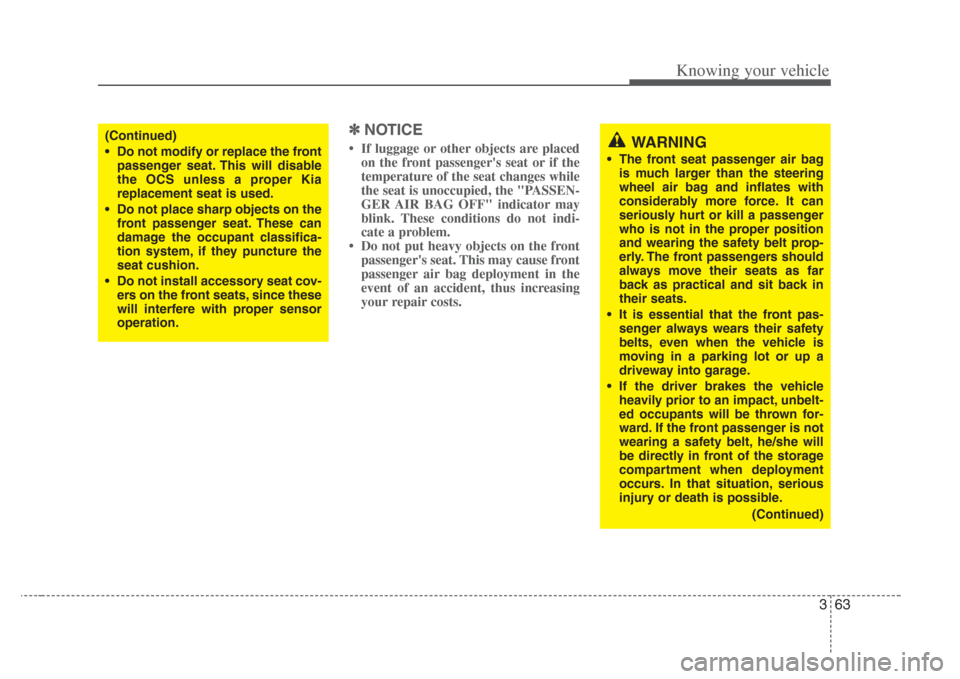
363
Knowing your vehicle
✽NOTICE
If luggage or other objects are placed
on the front passenger's seat or if the
temperature of the seat changes while
the seat is unoccupied, the "PASSEN-
GER AIR BAG OFF" indicator may
blink. These conditions do not indi-
cate a problem.
Do not put heavy objects on the front passenger's seat. This may cause front
passenger air bag deployment in the
event of an accident, thus increasing
your repair costs.WARNING
• The front seat passenger air bag
is much larger than the steering
wheel air bag and inflate s with
considerably more force. It can
seriously hurt or kill a passenger
who is not in the proper po sition
and wearing the safety belt prop-
erly. The front pa ssengers should
always move their seats a s far
back as practical and sit back in
their seats.
• It is e ssential that the front pas-
senger always wear s their safety
belts, even when the vehicle i s
moving in a parking lot or up a
driveway into garage.
• If the driver brakes the vehicle heavily prior to an impact, unbelt-
ed occupants will be thrown for-
ward. If the front pa ssenger is not
wearing a safety belt, he/she will
be directly in front of the storage
compartment when deployment
occur s. In that situation, serious
injur
y or death i s possible.
(Continued)
(Continued)
• Do not modify or replace the frontpassenger seat. This will disable
the OCS unless a proper Kia
replacement seat is used.
• Do not place sharp objects on the
front passenger seat. These can
damage the occupant cla ssifica-
tion system, if they puncture the
seat cushion.
• Do not install accessory seat cov-
er s on the front seats, since these
will interfere with proper sensor
operation.
Page 74 of 283
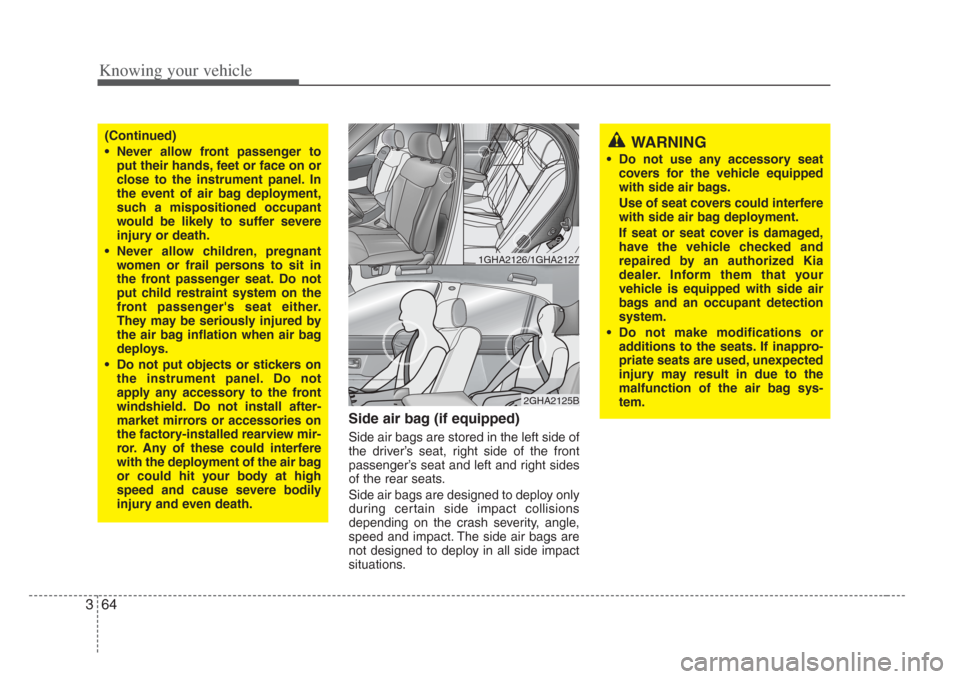
Knowing your vehicle
643
Side air bag (if equipped)
Side air bags are stored in the left side of
the driver’s seat, right side of the front
passenger’s seat and left and right sides
of the rear seats.
Side air bags are designed to deploy only
during certain side impact collisions
depending on the crash severity, angle,
speed and impact. The side air bags are
not designed to deploy in all side impact
situations.
WARNING
• Do not use any accessory seat
cover s for the vehicle equipped
with side air bags.
Use of seat cover s could interfere
with side air bag deployment.
If seat or seat cover is damaged,
have the vehicle checked and
repaired by an authorized Kia
dealer. Inform them that your
vehicle is equipped with side air
bags and an occupant detection
system.
• Do not make modifications or
additions to the seats. If inappro-
priate seats are u sed, unexpected
injury may result in due to the
malfunction of the air bag sys-
tem.
2GHA2125B
1GHA2126/1GHA2127
(Continued)
• Never allow front passenger to put their hand s, feet or face on or
clo se to the instrument panel. In
the event of air bag deployment,
such a mispositioned occupant
would be likely to suffer severe
injury or death.
• Never allow children, pregnant women or frail per sons to sit in
the front passenger seat. Do not
put child restraint system on the
front passenger's seat either.
They may be seriously injured by
the air bag inflation when air bag
deploys.
• Do not put object s or stickers on
the ins trument panel. Do not
apply any accessory to the front
windshield. Do not install after-
market mirror s or accessories on
the factory-installed rearview mir-
ror. Any of these could interfere
with the deployment of the air bag
or could hit your body at high
speed and cause severe bodily
injury and even death.
Page 75 of 283
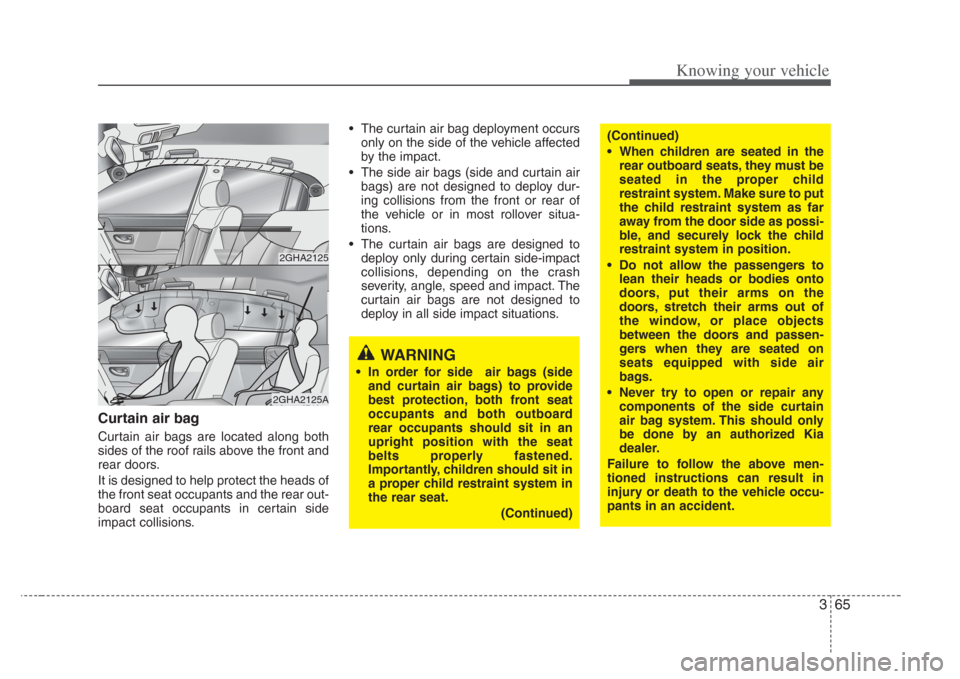
365
Knowing your vehicle
Curtain air bag
Curtain air bags are located along both
sides of the roof rails above the front and
rear doors.
It is designed to help protect the heads of
the front seat occupants and the rear out-
board seat occupants in certain side
impact collisions.• The curtain air bag deployment occurs
only on the side of the vehicle affected
by the impact.
• The side air bags (side and curtain air bags) are not designed to deploy dur-
ing collisions from the front or rear of
the vehicle or in most rollover situa-
tions.
• The curtain air bags are designed to deploy only during certain side-impact
collisions, depending on the crash
severity, angle, speed and impact. The
curtain air bags are not designed to
deploy in all side impact situations.
WARNING
• In order for side air bags ( side
and curtain air bag s) to provide
best protection, both front seat
occupants and both outboard
rear occupants should sit in an
upright pos ition with the s eat
belts properly fas tened.
Importantly, children should sit in
a proper child restraint system in
the rear seat.
(Continued)
(Continued)
• When children are seated in the
rear outboard seats, they must be
s eated in the proper child
restraint system. Make sure to put
the child restraint system as far
away from the door side as possi-
ble, and securely lock the child
restraint system in position.
• Do not allow the pa ssengers to
lean their head s or bodies onto
door s, put their arms on the
door s,stretch their arms out of
the window, or place objects
between the door s and passen-
ger s when they are seated on
s eats equipped with s ide air
bags.
• Never try to open or repair any components of the side curtain
air bag system.
This should only
be done by an authorized Kia
dealer.
Failure to follow the above men-
tioned ins tructions can res ult in
injury or death to the vehicle occu-
pants in an accident.
2GHA2125
2GHA2125A
Page 76 of 283
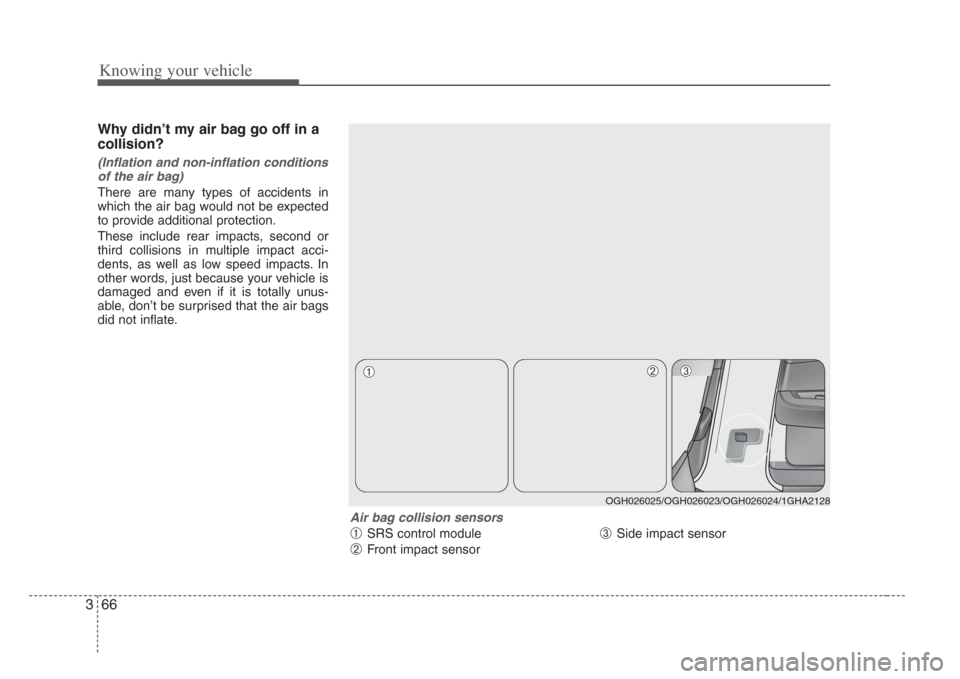
Knowing your vehicle
663
Why didn’t my air bag go off in a
collision?
(Inflation and non-inflation conditions
of the air bag)
There are many types of accidents in
which the air bag would not be expected
to provide additional protection.
These include rear impacts, second or
third collisions in multiple impact acci-
dents, as well as low speed impacts. In
other words, just because your vehicle is
damaged and even if it is totally unus-
able, don’t be surprised that the air bags
did not inflate.
Air bag collision sensors
➀ SRS control module
➁ Front impact sensor
➂ Side impact sensor
OGH026025/OGH026023/OGH026024/1GHA2128
➀➁➂
Page 77 of 283
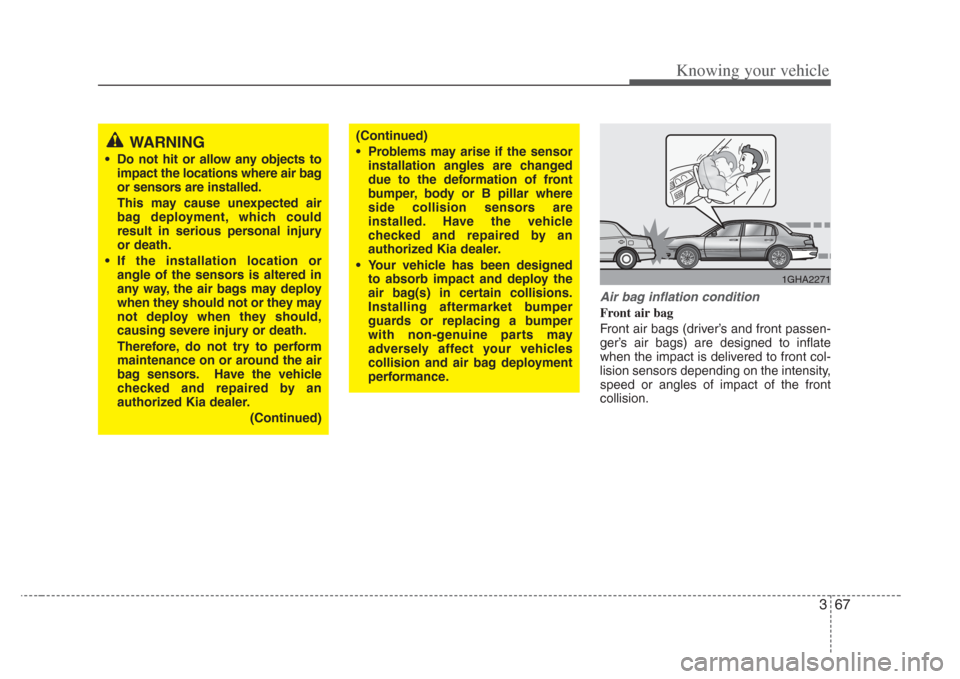
367
Knowing your vehicle
Air bag inflation condition
Front air bag
Front air bags (driver’s and front passen-
ger’s air bags) are designed to inflate
when the impact is delivered to front col-
lision sensors depending on the intensity,
speed or angles of impact of the front
collision.
WARNING
• Do not hit or allow any objects to
impact the locations where air bag
or sens ors are ins talled.
This may cause unexpected air
bag deployment, which could
result in serious per sonal injury
or death.
• If the ins tallation location or
angle of the sensor s is altered in
any way, the air bag s may deploy
when they should not or they may
not deploy when they s hould,
causing severe injury or death.
Therefore, do not try to perform
maintenance on or around the air
bag sensor s. Have the vehicle
checked and repaired by an
authorized Kia dealer.
(Continued)
(Continued)
• Problems may arise if the sensorinstallation angles are changed
due to the deformation of front
bumper, body or B pillar where
side collis ion sens ors are
ins talled. Have the vehicle
checked and repaired by an
authorized Kia dealer.
• Your vehicle has been designed to absorb impact and deploy the
air bag(s) in certain collisions.
Ins talling aftermarket bumper
guards or replacing a bumper
with non-genuine parts may
adver sely affect your vehicles
collision and air bag deployment
performance.
1GHA2271
Page 78 of 283
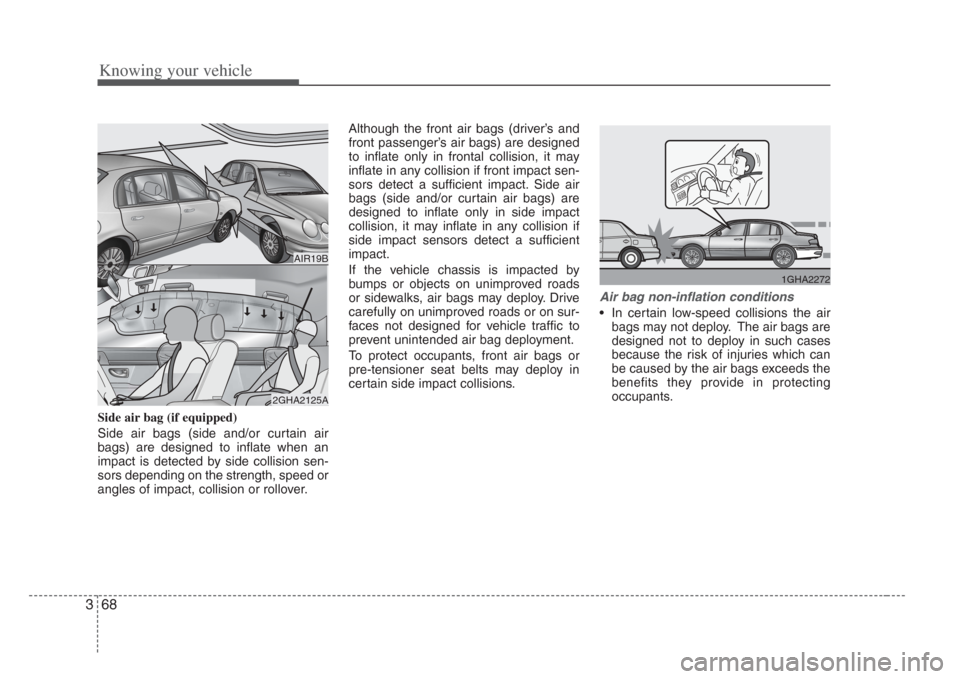
Knowing your vehicle
683
Side air bag (if equipped)
Side air bags (side and/or curtain air
bags) are designed to inflate when an
impact is detected by side collision sen-
sors depending on the strength, speed or
angles of impact, collision or rollover.Although the front air bags (driver’s and
front passenger’s air bags) are designed
to inflate only in frontal collision, it may
inflate in any collision if front impact sen-
sors detect a sufficient impact. Side air
bags (side and/or curtain air bags) are
designed to inflate only in side impact
collision, it may inflate in any collision if
side impact sensors detect a sufficient
impact.
If the vehicle chassis is impacted by
bumps or objects on unimproved roads
or sidewalks, air bags may deploy. Drive
carefully on unimproved roads or on sur-
faces not designed for vehicle traffic to
prevent unintended air bag deployment.
To protect occupants, front air bags or
pre-tensioner seat belts may deploy in
certain side impact collisions.
Air bag non-inflation condition
s
• In certain low-speed collisions the air
bags may not deploy. The air bags are
designed not to deploy in such cases
because the risk of injuries which can
be caused by the air bags exceeds the
benefits they provide in protecting
occupants.
AIR19B
2GHA2125A
1GHA2272
Page 79 of 283
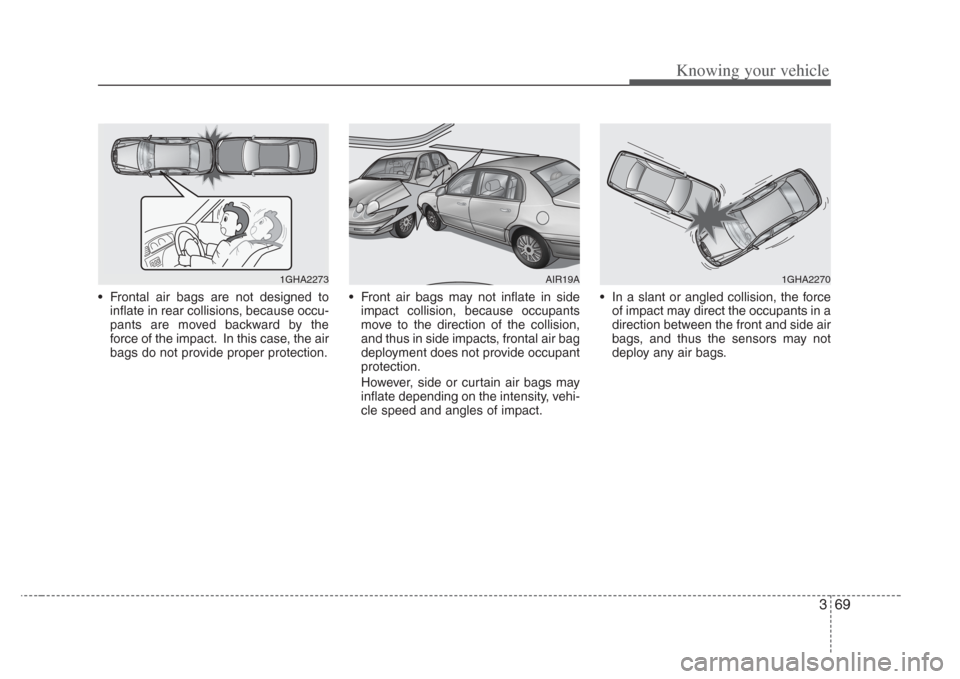
369
Knowing your vehicle
• Frontal air bags are not designed toinflate in rear collisions, because occu-
pants are moved backward by the
force of the impact. In this case, the air
bags do not provide proper protection. • Front air bags may not inflate in side
impact collision, because occupants
move to the direction of the collision,
and thus in side impacts, frontal air bag
deployment does not provide occupant
protection.
However, side or curtain air bags may
inflate depending on the intensity, vehi-
cle speed and angles of impact. • In a slant or angled collision, the force
of impact may direct the occupants in a
direction between the front and side air
bags, and thus the sensors may not
deploy any air bags.
1GHA2273AIR19A1GHA2270
Page 80 of 283
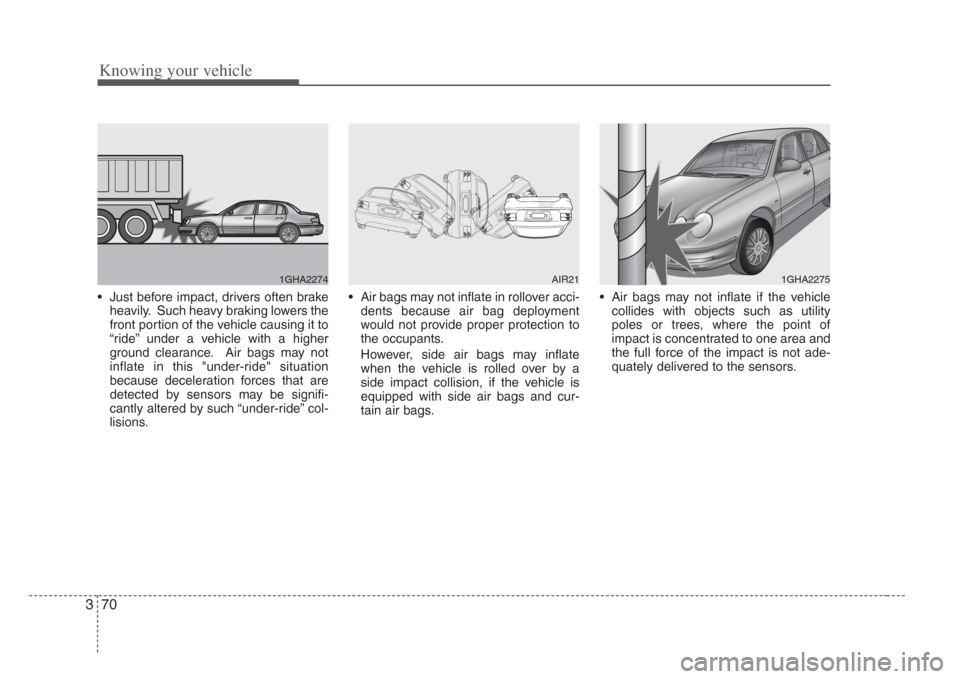
Knowing your vehicle
703
• Just before impact, drivers often brakeheavily. Such heavy braking lowers the
front portion of the vehicle causing it to
“ride” under a vehicle with a higher
ground clearance. Air bags may not
inflate in this "under-ride" situation
because deceleration forces that are
detected by sensors may be signifi-
cantly altered by such “under-ride” col-
lisions. • Air bags may not inflate in rollover acci-
dents because air bag deployment
would not provide proper protection to
the occupants.
However, side air bags may inflate
when the vehicle is rolled over by a
side impact collision, if the vehicle is
equipped with side air bags and cur-
tain air bags. • Air bags may not inflate if the vehicle
collides with objects such as utility
poles or trees, where the point of
impact is concentrated to one area and
the full force of the impact is not ade-
quately delivered to the sensors.
1GHA2274AIR211GHA2275